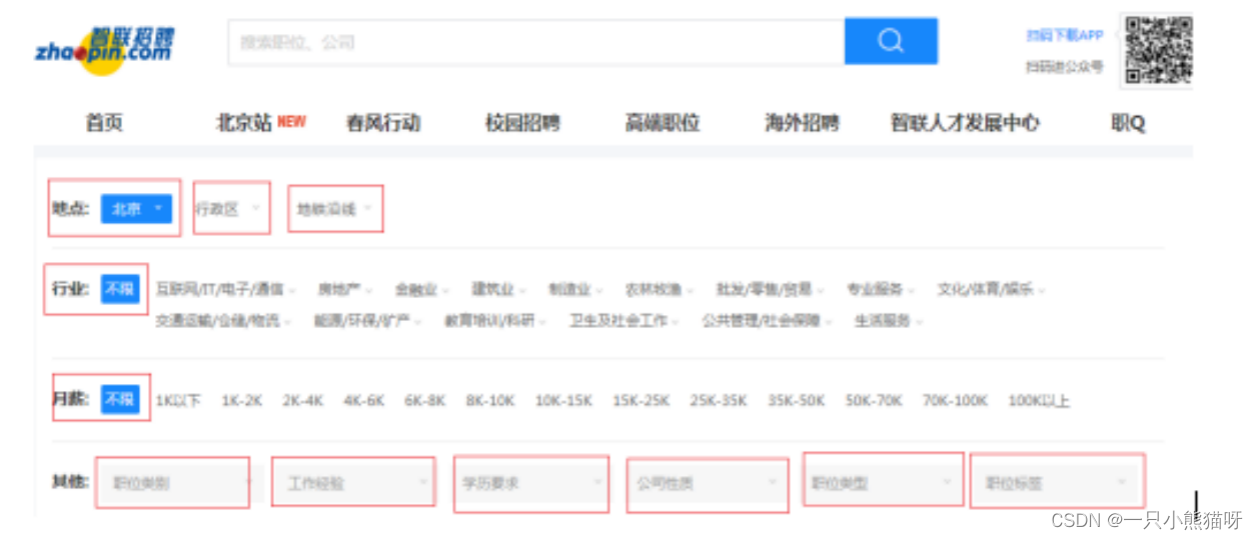四、MyBatis 动态语句
本章概要
- 动态语句需求和简介
- if 和 where 标签
- set 标签
- trim 标签(了解)
- choose/when/otherwise 标签
- foreach 标签
- sql 片段
4.1 动态语句需求和简介
经常遇到很多按照很多查询条件进行查询的情况,比如智联招聘的职位搜索等。其中经常出现很多条件不取值的情况,在后台应该如何完成最终的SQL语句呢?

动态 SQL 是 MyBatis 的强大特性之一。如果你使用过 JDBC 或其它类似的框架,你应该能理解根据不同条件拼接 SQL 语句有多痛苦,例如拼接时要确保不能忘记添加必要的空格,还要注意去掉列表最后一个列名的逗号。利用动态 SQL,可以彻底摆脱这种痛苦。
使用动态 SQL 并非一件易事,但借助可用于任何 SQL 映射语句中的强大的动态 SQL 语言,MyBatis 显著地提升了这一特性的易用性。
如果你之前用过 JSTL 或任何基于类 XML 语言的文本处理器,你对动态 SQL 元素可能会感觉似曾相识。在 MyBatis 之前的版本中,需要花时间了解大量的元素。借助功能强大的基于 OGNL 的表达式,MyBatis 3 替换了之前的大部分元素,大大精简了元素种类,现在要学习的元素种类比原来的一半还要少。
4.2 if 和 where 标签
使用动态 SQL 最常见情景是根据条件包含 where / if 子句的一部分。比如:
<!-- List<Employee> selectEmployeeByCondition(Employee employee); -->
<select id="selectEmployeeByCondition" resultType="employee">
select emp_id,emp_name,emp_salary from t_emp
<!-- where标签会自动去掉“标签体内前面多余的and/or” -->
<where>
<!-- 使用if标签,让我们可以有选择的加入SQL语句的片段。这个SQL语句片段是否要加入整个SQL语句,就看if标签判断的结果是否为true -->
<!-- 在if标签的test属性中,可以访问实体类的属性,不可以访问数据库表的字段 -->
<if test="empName != null">
<!-- 在if标签内部,需要访问接口的参数时还是正常写#{} -->
or emp_name=#{empName}
</if>
<if test="empSalary > 2000">
or emp_salary>#{empSalary}
</if>
<!--
第一种情况:所有条件都满足 WHERE emp_name=? or emp_salary>?
第二种情况:部分条件满足 WHERE emp_salary>?
第三种情况:所有条件都不满足 没有where子句
-->
</where>
</select>
4.3 set 标签
<!-- void updateEmployeeDynamic(Employee employee) -->
<update id="updateEmployeeDynamic">
update t_emp
<!-- set emp_name=#{empName},emp_salary=#{empSalary} -->
<!-- 使用set标签动态管理set子句,并且动态去掉两端多余的逗号 -->
<set>
<if test="empName != null">
emp_name=#{empName},
</if>
<if test="empSalary < 3000">
emp_salary=#{empSalary},
</if>
</set>
where emp_id=#{empId}
<!--
第一种情况:所有条件都满足 SET emp_name=?, emp_salary=?
第二种情况:部分条件满足 SET emp_salary=?
第三种情况:所有条件都不满足 update t_emp where emp_id=?
没有set子句的update语句会导致SQL语法错误
-->
</update>
4.4 trim 标签(了解)
使用 trim 标签控制条件部分两端是否包含某些字符
- prefix属性:指定要动态添加的前缀
- suffix属性:指定要动态添加的后缀
- prefixOverrides属性:指定要动态去掉的前缀,使用“|”分隔有可能的多个值
- suffixOverrides属性:指定要动态去掉的后缀,使用“|”分隔有可能的多个值
<!-- List<Employee> selectEmployeeByConditionByTrim(Employee employee) -->
<select id="selectEmployeeByConditionByTrim" resultType="com.atguigu.mybatis.entity.Employee">
select emp_id,emp_name,emp_age,emp_salary,emp_gender
from t_emp
<!-- prefix属性指定要动态添加的前缀 -->
<!-- suffix属性指定要动态添加的后缀 -->
<!-- prefixOverrides属性指定要动态去掉的前缀,使用“|”分隔有可能的多个值 -->
<!-- suffixOverrides属性指定要动态去掉的后缀,使用“|”分隔有可能的多个值 -->
<!-- 当前例子用where标签实现更简洁,但是trim标签更灵活,可以用在任何有需要的地方 -->
<trim prefix="where" suffixOverrides="and|or">
<if test="empName != null">
emp_name=#{empName} and
</if>
<if test="empSalary > 3000">
emp_salary>#{empSalary} and
</if>
<if test="empAge <= 20">
emp_age=#{empAge} or
</if>
<if test="empGender=='male'">
emp_gender=#{empGender}
</if>
</trim>
</select>
4.5 choose/when/otherwise 标签
在多个分支条件中,仅执行一个
- 从上到下依次执行条件判断
- 遇到的第一个满足条件的分支会被采纳
- 被采纳分支后面的分支都将不被考虑
- 如果所有的 when 分支都不满足,那么就执行 otherwise 分支
<!-- List<Employee> selectEmployeeByConditionByChoose(Employee employee) -->
<select id="selectEmployeeByConditionByChoose" resultType="com.atguigu.mybatis.entity.Employee">
select emp_id,emp_name,emp_salary from t_emp
where
<choose>
<when test="empName != null">emp_name=#{empName}</when>
<when test="empSalary < 3000">emp_salary < 3000</when>
<otherwise>1=1</otherwise>
</choose>
<!--
第一种情况:第一个when满足条件 where emp_name=?
第二种情况:第二个when满足条件 where emp_salary < 3000
第三种情况:两个when都不满足 where 1=1 执行了otherwise
-->
</select>
4.6 foreach 标签
基本用法,用批量插入举例
<!--
collection属性:要遍历的集合
item属性:遍历集合的过程中能得到每一个具体对象,在item属性中设置一个名字,将来通过这个名字引用遍历出来的对象
separator属性:指定当foreach标签的标签体重复拼接字符串时,各个标签体字符串之间的分隔符
open属性:指定整个循环把字符串拼好后,字符串整体的前面要添加的字符串
close属性:指定整个循环把字符串拼好后,字符串整体的后面要添加的字符串
index属性:这里起一个名字,便于后面引用
遍历List集合,这里能够得到List集合的索引值
遍历Map集合,这里能够得到Map集合的key
-->
<foreach collection="empList" item="emp" separator="," open="values" index="myIndex">
<!-- 在foreach标签内部如果需要引用遍历得到的具体的一个对象,需要使用item属性声明的名称 -->
(#{emp.empName},#{myIndex},#{emp.empSalary},#{emp.empGender})
</foreach>
批量更新时需要注意:
上面批量插入的例子本质上是一条SQL语句,而实现批量更新则需要多条SQL语句拼起来,用分号分开。也就是一次性发送多条SQL语句让数据库执行。此时需要在数据库连接信息的URL地址中设置:
atguigu.dev.url=jdbc:mysql:///mybatis-example?allowMultiQueries=true
对应的foreach标签如下:
<!-- int updateEmployeeBatch(@Param("empList") List<Employee> empList) -->
<update id="updateEmployeeBatch">
<foreach collection="empList" item="emp" separator=";">
update t_emp set emp_name=#{emp.empName} where emp_id=#{emp.empId}
</foreach>
</update>
关于foreach标签的collection属性:
如果没有给接口中List类型的参数使用@Param注解指定一个具体的名字,那么在collection属性中默认可以使用collection或list来引用这个list集合。这一点可以通过异常信息看出来:
Parameter ‘empList’ not found. Available parameters are [arg0, collection, list]
在实际开发中,为了避免隐晦的表达造成一定的误会,建议使用@Param注解明确声明变量的名称,然后在foreach标签的collection属性中按照@Param注解指定的名称来引用传入的参数。
4.7 sql 片段
抽取重复的 SQL 片段
<!-- 使用sql标签抽取重复出现的SQL片段 -->
<sql id="mySelectSql">
select emp_id,emp_name,emp_age,emp_salary,emp_gender from t_emp
</sql>
引用已抽取的 SQL 片段
<!-- 使用include标签引用声明的SQL片段 -->
<include refid="mySelectSql"/>
本文来自互联网用户投稿,该文观点仅代表作者本人,不代表本站立场。本站仅提供信息存储空间服务,不拥有所有权,不承担相关法律责任。 如若内容造成侵权/违法违规/事实不符,请联系我的编程经验分享网邮箱:chenni525@qq.com进行投诉反馈,一经查实,立即删除!
- Python教程
- 深入理解 MySQL 中的 HAVING 关键字和聚合函数
- Qt之QChar编码(1)
- MyBatis入门基础篇
- 用Python脚本实现FFmpeg批量转换
- OpenHarmony从入门到放弃(四)
- Java中的多态
- HDMI、VGA、DVI、DB接口的区别
- The ‘kotlin-android-extensions‘ Gradle plugin is no longer supported.
- SpringBoot+SSM项目实战 苍穹外卖(10) Spring Task WebSocket
- 工作流自动化:它是什么,常见示例以及如何实现
- 【归并排序】两个有序序列的合并
- 什么是图像中的掩膜(Mask),如何使用掩码
- Web APIs - 03
- 基于YOLOv8深度学习的100种蝴蝶智能识别系统【python源码+Pyqt5界面+数据集+训练代码】目标检测、深度学习实战